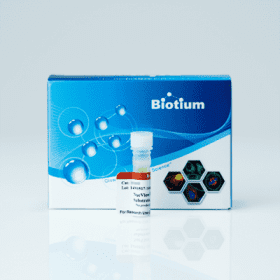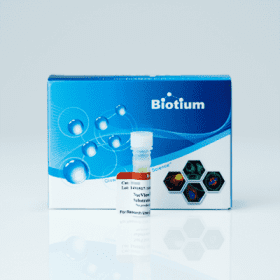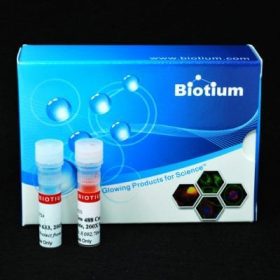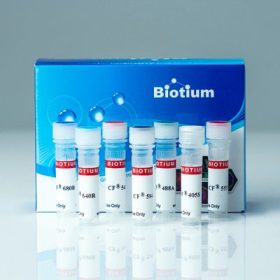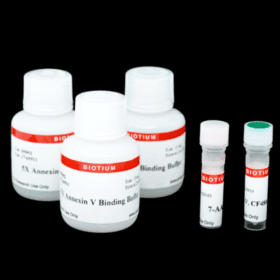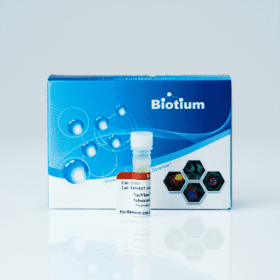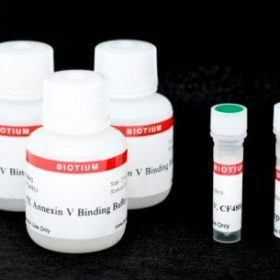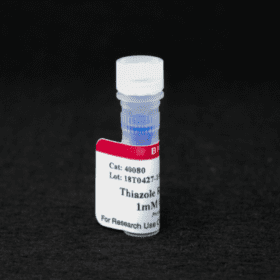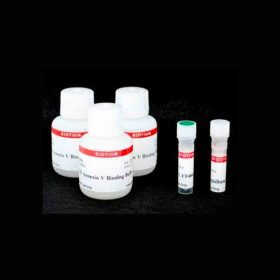Biotium products are distributed only in Singapore and Thailand.
The CF® dye TUNEL Assay Apoptosis Detection Kit label apoptotic cells in fixed tissue sections or cellular samples for fluorescence microscopy or flow cytometry.
Product Description
These kits use enzymatic labeling of DNA double-strand breaks to fluorescently stain apoptotic cells in fixed samples or tissue sections.
Features
- Direct labeling of DNA ds breaks with fluorescent dUTP
- Bright & photostable next-generation CF® dyes
- For fixed cells or tissue sections
- Detect by fluorescence microscopy or flow cytometry
Kit Components
- Equilibration Buffer
- CF® Dye TUNEL Reaction Buffer
- TdT Enzyme (calf thymus; recombinant, produced in E. coli)
Dye Options
- Green fluorescent CF®488A (Ex/Em 490/515 nm)
- Red fluorescent CF®594 (Ex/Em 593/614 nm)
- Far-red fluorescent CF®640R (Ex/Em 642/662 nm)
Learn more about Biotium’s next-generation CF® Dyes.
In the TUNEL assay, TdT enzyme catalyzes the addition of labeled dUTP to the 3′- ends of the internucleosomal DNA strand breaks that are a hallmark of apoptosis. The CF® dye TUNEL Assay Apoptosis Detection Kits employs dUTP conjugated to the exceptionally bright and photostable fluorescent dyes, for single step fluorescent TUNEL labeling of fixed cells or tissues for analysis by fluorescence microscopy or flow cytometry.
See our full selection of Cell Viability & Apoptosis Kits.
Product Attributes
| Apoptosis/viability marker | DNA fragmentation |
|---|---|
| For live or fixed cells | For fixed cells/tissue sections |
| Detection method/readout | Fluorescence microscopy, Flow cytometry |
| Assay type/options | Endpoint assay |
| Fixation options | Permeabilize before staining, Fix before staining (methanol), Fix before staining (formaldehyde) |
| Colors | Green, Red, Far-red |
| Product origin | TdT enzyme (calf thymus); recombinant, produced in E. coli |
| Storage Conditions | Store at -10 to -35 °C, Protect from light |
Reference Publications
Masayasu Toyomoto, Asuka Inoue, et al.
S1PR3–G12-biased agonist ALESIA targets cancer metabolism and promotes glucose starvation
Cell Chemical Biology 28, 1132–1144
DOI: https://doi.org/10.1016/j.chembiol.2021.01.004
Article Snippet: “HeLa cells were stained using the CF640R TUNEL assay apoptosis detection kit (Biotium) and Hoechst 33342, according to the manufacturers’ instructions.”
Zhihao Jia, Yaohui Nie, et al.
A requirement of Polo-like kinase 1 in murine embryonic myogenesis and adult muscle regeneration
eLife 8:e47097.
DOI: https://doi.org/10.7554/eLife.47097
Article Snippet: “For TUNEL and Pax7 staining, slides were fixed in 4% PFA for 10 min and then subjected to the TUNEL reaction using the CF488A TUNEL Assay Apoptosis Detection Kit (Biotium) according to the manufacturer’s instructions.”
Laura S. Shankman, Samantha T. Fleury, et al.
Efferocytosis by Paneth cells within the intestine
Current Biology 31, 2469–2476
DOI: https://doi.org/10.1016/j.cub.2021.03.055
Article Snippet: “One set of enteroids underwent apoptosis detection using the CF640R TUNEL Assay (Biotium #30074) allowing the reagent to sit for 2 hours at 37°C before EDU detection (GeneCopoeia #A003) for 30min.”
Kubelt, C., Molkewehrum, H., Lucius, R. et al.
Influence of Simulated Deep Brain Stimulation on the Expression of Inflammatory Mediators by Human Central Nervous System Cells In Vitro
Neuromol Med 24, 169–182 (2022).
DOI: https://doi.org/10.1007/s12017-021-08674-y
Article Snippet: “Apoptosis due to electrical stimulation was detected by TUNEL assays using CF® dye TUNEL Assay Apoptosis Detection Kit (Biotium, Inc., Fremont, CA) performed after 24 h of stimulation.”
Biyashev, D., Siwicka, Z.E., Onay, U.V. et al.
Topical application of synthetic melanin promotes tissue repair
npj Regen Med 8, 61 (2023)
DOI: https://doi.org/10.1038/s41536-023-00331-1
Article Snippet: “The TUNEL assay was performed using the CF®640 R Dye TUNEL assay apoptosis detection kits (Biotium, 30074) according to the manufacturer’s directions and visualized with an ECLIPSE Ti2 inverted microscope (Nikon Tokyo, Japan) using a DS-Qi2 camera (Nikon).”
Martin Kronschläger, Manuel Ruiß, Thomas Dechat, Oliver Findl
Single high-dose peroral caffeine intake inhibits ultraviolet radiation-induced apoptosis in human lens epithelial cells in vitro
Acta Ophthalmol, 99: e587-e593.
DOI: https://doi.org/10.1111/aos.14641
Article Snippet: “Afterwards, lens capsules were stained using a commercial TdT-mediated dUTP-biotin nick end labeling (TUNEL) assay kit (CF 594; TUNEL Assay Apoptosis Detection Kit; Biotium, Fremont, CA, USA).”
Masahiro Miyata, Eri Matsuki, Kazunobu Ichikawa, et al.
Allogeneic T cells cause acute renal injury after hematopoietic cell transplantation
Blood Adv (2023) 7 (22): 6936–6948.
DOI: https://doi.org/10.1182/bloodadvances.2023009721
Article Snippet: “After removing the floating cells and medium, the wells were washed with phosphate-buffered saline, followed by terminal deoxynucleotidyl transferase–mediated deoxyuridine triphosphate nick end labeling (TUNEL) using the CF 594 TUNEL Assay Apoptosis Detection Kit (Biotium, Fremont, CA).”



